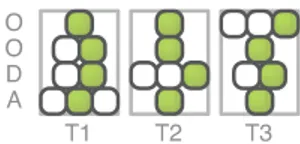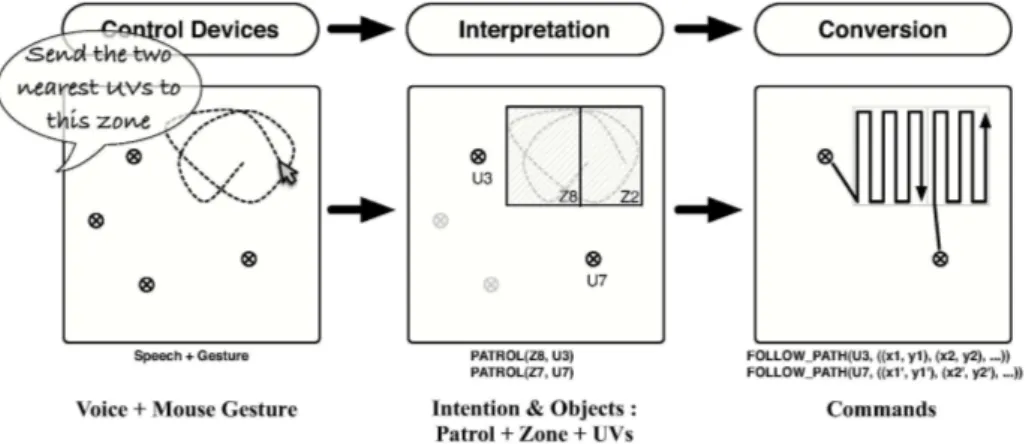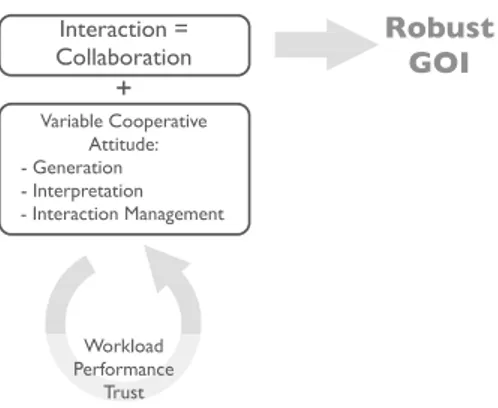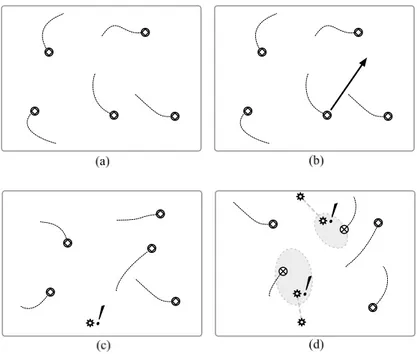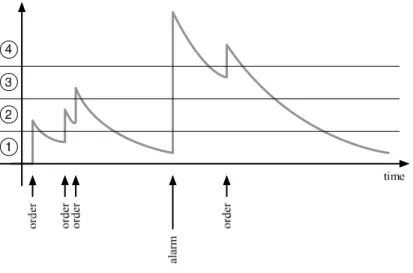HAL Id: hal-00336200
https://hal.archives-ouvertes.fr/hal-00336200
Submitted on 3 Nov 2008
HAL is a multi-disciplinary open access
archive for the deposit and dissemination of
sci-entific research documents, whether they are
pub-lished or not. The documents may come from
teaching and research institutions in France or
abroad, or from public or private research centers.
L’archive ouverte pluridisciplinaire HAL, est
destinée au dépôt et à la diffusion de documents
scientifiques de niveau recherche, publiés ou non,
émanant des établissements d’enseignement et de
recherche français ou étrangers, des laboratoires
publics ou privés.
Cooperative interface for a swarm of UAVs
Sylvie Saget, Francois Legras, Gilles Coppin
To cite this version:
Sylvie Saget, Francois Legras, Gilles Coppin. Cooperative interface for a swarm of UAVs. First
Confer-ence on Humans Operating Unmanned Systems (HUMOUS-08), Sep 2008, Brest, France. pp.173-188.
�hal-00336200�
Cooperative Interface for a Swarm of UAVs
Sylvie Saget1,2, Fran¸cois Legras1,2
, and Gilles Coppin1,2
1
Institut TELECOM; TELECOM Bretagne; UMR CNRS 3192 Lab-STICC, France
2
Universit´e Europ´eenne de Bretagne, France
Abstract. After presenting the broad context of authority sharing, we outline how introducing more natural interaction in the design of the ground operator interface of UV systems should help in allowing a single operator to manage the complexity of his/her task. Introducing new modalities is one one of the means in the realization of our vision of next-generation GOI. A more fundamental aspect resides in the interaction manager which should help balance the workload of the operator between mission and interaction, notably by applying a multi-strategy approach to generation and interpretation.
We intend to apply these principles to the context of the Smaart pro-totype, and in this perspective, we illustrate how to characterize the workload associated with a particular operational situation.
1
Introduction
Unmanned Vehicle (UV) Systems will considerably evolve within the next two decades. Actually, in the current generation of UV Systems, several ground op-erators operate a single vehicle with limited autonomous capabilities. Whereas, in the next generation of UV Systems, a ground operator will have to super-vise a system of several cooperating vehicles performing a joint mission, i.e. a Multi-Agent System (MAS) [10,12]. In order to enable mission control, vehicles autonomy will increase [7] and will require new forms of Human-system interac-tion.
In this context, we have developed a prototype multi-UV ground control station (Smaart) that allows an operator to supervise the surveillance of a sim-ulated strategic airbase by a swarm of rotary-wing UVs [13]. In this system, the autonomous behavior of the UVs is generated by the means of a dual digital pheromone algorithm (bio-inspired approach), and although we obtained inter-esting results, the operator-system interaction is rather basic: place beacons in the environment, dispatch UVs towards these beacons, select mode of informa-tion display, etc. Despite being technically an authority sharing system, Smaart is only the first step in the development of a full-fledged authority sharing con-trol system for swarms of UVs. Two main challenges have to be faced in order to design such an efficient and realistic UV Systems:
1. obviating the negative side effects of automation: workload mitigation, loss of situation awareness, complacency, skill degradation, etc [17];
2. decreasing the cognitive load induced for the ground operator. Operating UV systems is highly complex. Obviously, shifting to UV Systems with sev-eral vehicles will makes mission and vehicles control more complex [6]. In addition, even though increasing vehicles’ autonomy aims at decreasing the cognitive load induced by mission control for ground operators, workload mitigation may lead to even higher workload [17,6].
While using an UV System’s interface, the ground operator is at least engaged within two activities: mission control and interaction. However, all in all, the great majority of study focus on mission control. In this paper, we claim that interaction design must be considered as a field of research by itself. In this perspective, as [25,9] we claim that there is a need to enhance the naturalness of ground operator interface rather than only improving mission realization and control. But as soon as an interface provides “natural” input and/or output devices, non-understandings and misunderstandings may occur. Then, in order to design efficient UV Systems, the problem of robustness of the interaction has to be handled.
Based on recent advances in Pragmatics and in Human-Computer Inter-face [4,22,18,19], we present a collaborative view of interaction dedicated to UV Systems. Considering interaction as a collaborative activity while designing an interface enhances its robustness [20], opens the door to managing the global workload of the operator through a balance effect between mission load and interaction load [16].
2
Perspective on Authority Sharing
This section presents the backdrop of our research on authority sharing for un-manned systems control. The basic requirement for an authority sharing system is to provide several distinct operating modes to accomplish a given task or function. Fig. 1 illustrates how we represent the different operating modes for three tasks, decomposed along John Boyd’s OODA loop [23]. In this example, the system has only one operating mode for the Observe stage of T1, but two alternative modes for Orient and Decide, and three modes for Act.
Fig. 1.Representation of the operating modes for three tasks (T1, T2, T3).
Each operating mode gives specific authority and responsibilities to the op-erator and the system. For example, the Act stage of the landing task of an UV could provide three modes: (a) full manual i.e. the operator tele-operates the
Fig. 2.Authority sharing concepts in single system–single operator interactions.
UV; (b) full auto i.e. the vehicle lands automatically with no possible interven-tion of the operator; and (c) auto with veto, where the operator can disconnect the auto-pilot and handle the landing.
As we see on Fig. 2, in order to control the system at time t, an operating mode must be activated for each task and stage in OODA (filled cells on Fig. 1). Therefore, the main question is “which operating mode has to be selected at time t?” This corresponds to a second level of authority sharing i.e. the authority to assign responsibilities (select operating modes) and must be implemented as some sort of decision process. Indeed, in a full-fledged authority-sharing system, the operators and the machines could have different preferences concerning which operating modes should be selected.
We can consider that the operators and the system’s internal representations can be broadly decomposed along the same three categories:
– models and representations of the situation: his corresponds to the repre-sentation of objects in the system’s environment, knowledge about its laws, properties, etc.: this can be seen as a “world model”;
– models and representations of the system: his corresponds to the current state of the system, its known capabilities, predictions about its evolution, etc.;
– models and representations of the operator: similarly this represents the state of the operator, his/her abilities, performances, etc.
If one combines these categories with the two kind of actors (machine and Humans), we obtain six distinct fields of research relevant to the development of authority sharing systems. Without being exhaustive, one can identify:
– work on human situational awareness (representation of the situation on the operator’s side);
– work on trust in automation (representation of the system on the operator’s side);
– cognitive and physiological modeling (representation of the operator on the system’s side).
System’s and operator’s representations are not only fed by observation of the situation (as illustrated on Fig. 2), but also through interaction between Hu-man and machine. Man-machine interaction can happen on several media (from classic mouse & keyboard, joystick to advanced haptic interfaces or dialogue) but whatever the chosen media, it should tend to facilitate the convergence be-tween the respective representations of Humans and machines involved. Again, we consider here another field of research by itself. And one can note that an efficient interaction will decrease the difficulty of the final decision-making pro-cess as converging representations on the Human and machine’s sides lead to converging preferences on which operating modes to select.
3
Naturalness
In the current generation of UV Systems, Ground Operator Interface (GOI) is a traditional Graphical User Interface, such as [11]. These are based on in-put/output modalities such as drop-down menu or push button, with a con-strained interaction language, providing quantitative spatial information and interaction, etc. This interaction language is similar to the low-level command language for vehicles, with quantitative spatial information for example. Thus, GOI naturalness is poor. However, current works aims at enhancing the natural-ness of interface [3]. That is integrating a less-constrained interaction, at least a single natural modality as input [16,9] (such as gesture, spoken or written language) or output [9] (such as speech, haptic display), multi-modality, flexible interaction [12], providing qualitative spatial information and interaction etc.
As soon as naturalness is introduced within the GOI, non-understandings – due to vagueness, ambiguity or underspecification – have to be managed. Inter-active management of non-understandings follows from the collaborative nature of interaction (grounding) and requires a new GOI component: an interaction manager [20]. Such an approach has been used within The WITAS project [14] as well as within the GeoDialogue Project [2], which relates to Geographical Information Systems.
Enhancing GOI naturalness has various benefits for UV Systems. First, a more natural interaction between an interface and its user generally enhances the efficiency of interaction i.e. it reduces the cognitive load induced by the interaction for the user as well as interaction time. For example, a data entry
function based on vocal keyword recognition may require a single vocal utterance in the next generation of GOI, while it may require over twenty separate manual actions in the current generation of GOI.
Moreover, natural display modality (typically, haptic display) also aims at making up for the “sensory isolation” of the ground operator [9]. Operator’s sensory isolation is due to the fact that he is generally not collocated in the same physical space than vehicles [8,21]. This leads to lack of situation awareness, among others negative effects.
Supervisory control of UV systems mainly involves spatial cognition and ref-erence to vehicles, landmarks, waypoints, etc. To the extend that human beings performs these tasks using qualitative information and interact through gesture and verbal communication, GOI naturalness should focus on spatial information and interaction. Nonetheless our goal is not to transform the GOI in a fully natural interface. But, as soon as naturalness is introduced within an interface, side effects have to be carefully considered. In particular, the GOI must contain new functionalities: being a semantic bridge between operators and vehicles, and handling of non-understandings.
Fig. 3.Ground operator interface: a semantic bridge.
First, considering “natural” input device (i.e. corresponding to a control command from the ground operator to a vehicle), there is a mismatch between the “natural” command provided by the operator and the “operational” com-mand that a vehicle can accept. Then, the ground operator interface must be a semantic bridge, that converts the perceived message in a representation which is suitable for the addressee. That is to say that following the perception of an input on a control input device and following its interpretation, GOI also has to convert the understood control command before transmitting it to the proper vehicle(s). As shown on Fig. 3:
– the front part the GOI has to detect input on a control input device and has to transmit the raw message to the interpretation module;
– the interpretation module identifies the intend meaning of the operator: the kind of control command and the intended objects, the two vehicles which are the recipients of the message and the intended pre-defined zone; – the conversion module has to:
1. translate operator command into the language which is proper for the addressee;
2. process the underspecified elements, such as path planning. The conver-sion module may lack necessary information, such as the first waypoint. In this case, a completion request has to be send to the ground operator in order to complete the command conversion.
Second, as soon as an interface provides semi-constrained interaction, qualita-tive spatial interaction [2], natural (multi-)modality [22], then non-understandings may occur. Non-understanding is commonly set apart misunderstanding. In a misunderstanding, the addressee succeeds in communicative act’s interpretation, whereas in a non-understanding he fails. But, in a misunderstanding, addressee’s interpretation is incorrect. For example, mishearing may lead to misunderstand-ing.
Handling non-understandings is necessary for the GOI as soon as an in-put control command cannot be transmitted to vehicles. Human beings handle non understandings by interactively refining their understanding until a point of intelligibility is reached. This process is called “grounding” [4]. In order to design grounding, interaction has to be viewed as a collaborative process and an interaction manager has to be integrated within the GOI. For more details, the interested reader may refer to [20]. There is a common misconception that non-understandings are considered as “communicative errors” one may tend to avoid, as well as understanding refinement. Although, either for Human-Human Interaction [5] or for Human-Computer Interaction [15], non-understandings and their management process present lots of advantages. For example, feedbacks are cue that enable interaction partners to be aware of the level of understanding of each other. Through interaction refinement each interaction partner maintains an accurate representation of the other and this enhances the efficiency of future interactions.
More generally, enhancing interaction design may lead to positive side effects enhancing mission control. If one takes the example of gesture, as explained in the previous section, enabling the ground operator to interact using gesture aims at making efficient references. Actually, gestures facilitate the maintenance of spa-tial representations in working memory [24]. Therefore, gestures may contribute to maintaining the situation awareness that enables an efficient supervisory con-trol by the operator.
4
Balancing Mission & Interaction
While using an UV System’s interface, the ground operator is at least engaged within two activities: mission control and interaction. This is the general case of all goal-oriented interaction (or dialogue):
Dialogues, therefore, divide into two planes of activity [4]. On one plane, people create dialogue in service of the basic joint activities they are en-gaged in making dinner, dealing with the emergency, operating the ship. On a second plane, they manage the dialogue itself – deciding who speaks when, establishing that an utterance has been understood, etc. These two planes are not independent, for problems in the dialogue may have their source in the joint activity the dialogue is in service of, and vice versa. Still, in this view, basic joint activities are primary, and dialogue is cre-ated to manage them. [1]
Interaction is defined by each dialog partner’s goals to understand each other, i.e. words to reach a certain degree of intelligibility, sufficient for the current purpose. The crucial points here are that :
1. perfect understanding is not required, the level of understanding required is directed by the basic activity (i.e. the mission) and the situational context (e.g. time pressure);
2. as ground operator’s cognitive load is “divided” between the cognitive loads induced by each activity, the interaction’s complexity must vary depending on the complexity involved by the mission, as defined by Mouloua and al. [16]. For example, as time pressure rises, the cognitive load induced by the mission increases. The cognitive load required by the interaction should decrease in order to carry through the mission.
In the perspective of adapting adapt the grounding process to the specific case of the supervision of multiple UVs, one can note that a GOI is also an interaction support for a team, therefore similar to interfaces dedicated to Com-puter Supported Cooperative Work. However, the team include humans (ground operators) and machines (vehicles). The GOI is also an interaction partner of ground operators. They interact for decision support tasks, non-understanding management and interface manipulation.
In addition, our study aims at designing interaction in order to take advan-tage of the mutual dependancy between mission control and interaction. More precisely, we propose adaptive interaction design in order to obtain the prop-erties defined by Mouloua and al. [16,20]. The point is to obviate the negative side effects of automation, through balanced workload. We claim that adapting interaction design in regards human factors such as operator’s workload, trust or performance must have positive side effects on these human factors, cf. Figure 4. The GOI we are developing will integrate an Interaction Manager compo-nent, responsible for choosing adequate strategies for (1) generation and (2) interpretation:
Fig. 4.Interaction as a collaborative and adaptive process.
1. for a given information or interaction to be potentially send to the operator, deciding whether to send it or not and choosing a modality and formulation; 2. trying to understand interactions emanating from the operator, given the
current context and grounding information.
Several redundant strategies will have to be developed for the various possible interactions permitted by the GOI. For a given interaction, some strategies will put the burden of interaction on the GOI (disambiguation, acknowledgement, etc.) while others will rest more “on the shoulders” of the operator. The rationale is that in situations of low “mission workload”, one is better off with giving more work the operator as it builds up the grounding all the while keeping him/her busy (fending off boredom and loss of attention). Conversely, in mission critical episodes, the GOI can assume a more active role in interaction and let the operator focus on the mission (and still be robust thanks to the grounding constructed earlier).
5
Situation Cueing for the GOI of a Swarm of UVs
In addition to designing different strategies for generation and interaction, we have to give to the interaction manager some means to evaluate the current state of the mission (and therefore make an estimation of the associated workload) in order to choose strategies. In this section, we illustrate how – in the perspective of the extension of the Smaart system (see [13] in this volume) – we intend to discriminate four categories of mission states and their associated workloads. 5.1 Description
The Smaart system allows patrol and intercept operations for a dozen of rotary-wing UAVs supervised by a single operator.
Fig. 5. Illustration of levels of workload. Symbols and correspond to – respectively – patrolling and pursuing UVs. The symbols correspond to alarms. Thick dotted lines link alarms that are supposed to have been triggered by the same intruder, while greyed-out regions are search zones with adjustable parameters (center, direction and breadth). Recent alarms are indicated by an exclamation mark (!).
Subfigure 5a illustrates the lowest level of workload: Routine Patrol. The UAVs perform their surveillance with a stable performance, every point on the airbase is scanned at an acceptable frequency. In this context, the task of the operator is purely of a supervisory nature. The parameters of the display are set to values known to be adequate for the current setup (number of UAVs, area, threat level, etc. see [13] in this volume). The operator has a good appreciation of the reliability of the algorithm (good) and knows that anomalies are rare.
Due to its local nature, the algorithm that the UAVs use to perform their coordinated patrol can misbehave in some configurations.3
In such cases, the operator can detect the anomaly and take actions by dispatching some UAVs manually to compensate for the anomaly. In this context he/she has to closely
3
For example, if for some reasons an “islet” appear in the digital pheromone space, the gradient-following UAVs will never reach it, and consequently, a dark spot will appear and worsen. This local processing on the part of the UAVs has some interesting properties, but also has the consequence that a modification in a part of the airbase (e.g. creation of a no-fly zone) will take some time to be propagated to the rest of the environment though the digital pheromone.
supervise the execution of these actions, judge their effectiveness, all the while continuing his/her global supervising activity of the patrol on the whole airbase. One can detect such a workload level (Patrol with Anomaly) by the action of the operator on an UAV (Subfigure 5b).
The two next workload levels are characterized by the presence of alarms. The number of alarms in recent time allows to distinguish low threat Alarm (possible false alarm, Subfigure 5c) from emergency situation (multiple alarms, coordinated Intrusion, Subfigure 5d). In this last situation, the general surveil-lance of the airbase is largely jeopardized, as (1) many UAVs are used to pursue the intruders in specific regions, therefore depleting the patrolling vehicles. And, (2) the attention of the operator is largely focused on the intrusions.
5.2 Characterization
Table 1 sums up the characterization of the operational situations we intend to implement in Smaart.
1 No activity on the part of the operator (no command sent to the UAVs) 2 At least a command sent to a UAV in the last few minutes
3 One alarm in the last few minutes 4 Several alarms in the last few minutes
Table 1.Characterization of the four levels of mission workload in Smaart.
Based on these criterions, the interaction manager is able to compute a dis-crete mission workload level at every moment: either (1) by storing every events (operator action toward UAVs or alarms) and matching with the criterions of table 1, or (2) by updating a continuous workload level by the combination of fixed additive values associated to alarms and orders with a discount temporal factor (see Figure 6). With the latter option, the continuous level is compared to pre-defined thresholds to obtain discrete levels.
6
Conclusion & Perspectives
In the broad context of authority sharing, we have outlined how introducing more natural interaction in the design of the ground operator interface of UV systems should help in allowing a single operator to manage the complexity of his/her task. Introducing new modalities is one one of the means in the realization of our vision of next-generation GOI. A more fundamental aspect resides in the interaction manager which should help balance the workload of the operator between mission and interaction, notably by applying a multi-strategy approach to generation and interpretation.
Fig. 6.Illustration of the computation of the four levels of mission workload.
We intend to apply these principles to the context of the Smaart prototype, and in this perspective, we have illustrated how to characterize the workload associated with a particular operational situation.
References
1. A. Bangerter and H.H. Clark. Navigating joint projects with dialogue. Cognitive Science, 27:195–225, 2003.
2. G. Cai, H. Wang, and A. M. Mac Eachren. Communicating vague spatial concepts in human-GIS interactions: A collaborative dialogue approach. Spatial Information Theory, pages 287—300, 2003.
3. J.Y.C. Chen, E.C. Haas, K. Pillalamarri, and C.N. Jacobson. Human robot inter-face: Issues in operator performance, interface design, and technologies. Technical Report ARL-TR-3834, Army Research Laboratory (ARL), Aberdeen, July 2006. 4. H. H. Clark. Using language. Cambridge University Press, Cambridge, UK, 1996. 5. P. Cohen, H. Levesque, J. Nunes, and S. Oviatt. Task-oriented dialogue as a consequence of joint activity. In Proceedings of PRICAI-90, pages 203–208, 1990. 6. M.L. Cummings, S. Bruni, S. Mercier, and P.J. Mitchell. Automation
architec-ture for single operator, multiple UAV command and control. The International Command and Control Journal, 1(2):1–24, 2007.
7. S. Dixon and C. Wickens. Control of multiple-UAVs : A workload analysis. In Proceedings of the 12th International Symposium on Aviation Psychology, 2001. 8. M.R. Endsley. Toward a theory of situation awareness in dynamic systems. Human
Factors, 37(1):32–64, 1995.
9. D.V. Gunn, W.T. Nelson, R.S. Bolia, J.S. Warm, D.A. Schumsky, and K.J. Corco-ran. Target acquisition with UAVs: Vigilance displays and advanced cueing inter-faces. In Proceedings of the Human Factors and Ergonomics Society 46th Annual Meeting, pages 1541–1545, 2002.
10. C. Johnson. Inverting the control ratio : Human control of large, autonomous teams. In Proceedings of AAMAS’03 Workshop on Humans and Multi-Agent Sys-tems, 2003.
11. W.S. Kim. Graphical operator interface for space telerobotics. In Proceedings of the IEEE International Conference on Robotics and Automation, pages 761–768, 1993.
12. F. Legras and G. Coppin. Autonomy spectrum for a multiple UAVs system. In COGIS’ 07 - COgnitive systems with Interactive Sensors, 2007.
13. Fran¸cois Legras. Experiments in human operation of a swarm of UAVs. In Pro-ceedings of the first conference on Humans Operating Unmanned Systems (HU-MOUS’08), Brest, France, 3-4 Sept. 2008.
14. O. Lemon, A. Gruenstein, L. Cavedon, and S. Peters. Collaborative dialogue for controlling autonomous systems. In Proceedings of AAAI Fall Symposium, 2002. 15. B. Martinovski and D. Traum. Breakdown in human-machine interaction: the error
is the clue. In Proceedings of the ISCA tutorial and research workshop on Error handling in dialogue systems, pages 11–16, 2003.
16. M. Mouloua, Gilson, J. R., Kring, and P.A. Hancock. Workload, situation aware-ness, and teaming issues for UAV/UCAV operations. In Proceedings of the Human Factors and Ergonomics Society, volume 45, pages 162–165, 2001.
17. R. Parasuraman, T.B. Sheridan, and C.D. Wickens. A model for types and levels of human interaction with automation. IEEE Transactions on Systems, Man, and Cybernetics - Part A: Systems and Humans, 30:286–297, 2000.
18. M. J. Pickering and S. Garrod. Toward a mechanistic psychology of dialogue. Behavioral and Brain Sciences, 27:169–225, 2004.
19. S. Saget and M. Guyomard. Goal-oriented dialog as a collaborative subordinated activity involving collaborative acceptance. In Proceedings of Brandial’06, pages 131–138, University of Potsdam, Germany, 2006.
20. S. Saget, F. Legras, and G. Coppin. Collaborative model of interaction and un-manned vehicle systems’ interface. In HCP workshop on ”Supervisory Control in Critical Systems Management”, 3rd International Conference on Human Centered Processes (HCP-2008), Delft, The Netherlands, 2008.
21. D.H. Sonnenwald, K.L. Maglaughlin, and M.C. Whitton. Designing to support situation awareness across distances: an example from a scientific collaboratory. Information Processing & Management, 8(6):989–1011, 2004.
22. D. Traum. A Computational Theory of Grounding in Natural Language Conversa-tion. PhD thesis, Computer Science Deptartment, University of Rochester, 1994. 23. David G. Ullman. “OO-OO-OO!” the sound of a broken OODA loop. Crosstalk,
April 2007.
24. J. Wesp, R.and Hesse, D. Keutmann, and K. Wheaton. Gestures maintain spatial imagery. American Journal of Psychology, 114(1):591–600, 2001.
25. D.T. Williamson, M.H Draper, G.L. Calhoun, and T.P. Barry. Commercial speech recognition technology in the military domain: Results of two recent research ef-forts. International Journal of Speech Technology, 8(1):9–16, 2005.
